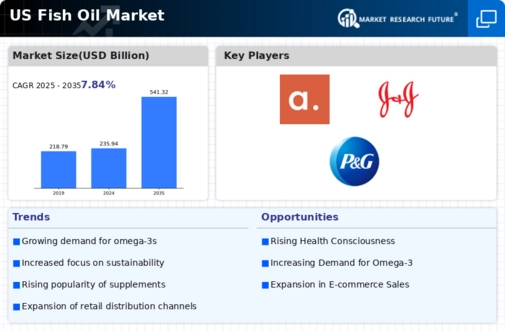Growing Health Consciousness
The fish oil market is experiencing a notable surge in demand, driven by an increasing awareness of health and wellness among consumers. As individuals become more health-conscious, they are actively seeking dietary supplements that offer potential benefits, such as improved cardiovascular health and cognitive function. According to recent data, the market for omega-3 fatty acids, a key component of fish oil, is projected to grow at a CAGR of approximately 8% over the next five years. This trend indicates a robust interest in fish oil products, as consumers prioritize preventive health measures and seek to incorporate beneficial nutrients into their diets.
Increased Online Retail Presence
The fish oil market is benefiting from the increased online retail presence, which has transformed the way consumers purchase dietary supplements. E-commerce platforms provide convenience and accessibility, allowing consumers to easily compare products and read reviews before making a purchase. This shift towards online shopping has been accelerated by the growing trend of health and wellness, as consumers seek to find the best fish oil products to meet their needs. Data indicates that online sales of dietary supplements, including fish oil, have seen a significant rise, with projections suggesting that this channel could account for over 30% of total sales in the coming years.
Innovations in Product Formulations
The fish oil market is witnessing a wave of innovations in product formulations, which is enhancing consumer appeal and driving market growth. Manufacturers are increasingly developing new delivery formats, such as gummies, soft gels, and liquid forms, to cater to diverse consumer preferences. Additionally, advancements in technology have led to improved purification processes, resulting in higher quality and more concentrated omega-3 products. This innovation not only attracts new customers but also encourages existing consumers to explore different product options. As a result, the fish oil market is likely to expand, with innovative products capturing a larger share of consumer spending.
Rising Incidence of Chronic Diseases
The fish oil market is significantly influenced by the rising incidence of chronic diseases, such as heart disease, diabetes, and obesity. These health issues have prompted consumers to explore dietary supplements that may help mitigate risks associated with these conditions. Research suggests that omega-3 fatty acids found in fish oil can play a role in reducing inflammation and improving heart health. As a result, the demand for fish oil products is likely to increase, with consumers turning to these supplements as part of their overall health management strategies. The market is expected to see a continued rise in sales as awareness of the health benefits of fish oil becomes more widespread.
Regulatory Support for Nutritional Supplements
The fish oil market is positively impacted by regulatory support for nutritional supplements, which fosters consumer confidence and encourages market growth. In the US, agencies such as the FDA provide guidelines and regulations that ensure the safety and efficacy of dietary supplements, including fish oil products. This regulatory framework not only protects consumers but also promotes innovation within the industry. As manufacturers comply with these regulations, they can market their products more effectively, leading to increased sales. The supportive regulatory environment is likely to continue to bolster the fish oil market, as consumers feel more secure in their purchasing decisions.














Leave a Comment